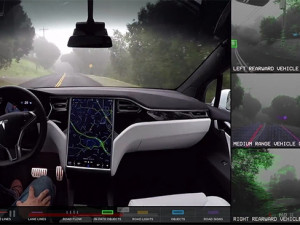
As Tesla races to have the first fully autonomous vehicle on the roads, it releases snippets showing how its self-driving software will work.
The latest is a glimpse into how the vehicle's series of cameras will identify objects around the car and react to them. South African-born CEO Elon Musk tweeted a link to a video of a self-driving demonstration this weekend.
The video features a passenger in the driver's seat, but the company says this is only for legal reasons and the car is driving itself. On the right hand side of the video, the viewer can see what the left rearward camera, medium range vehicle camera, and right rearward camera see.
Each camera identifies other cars, road signs, pedestrians and road lines. At the end, the passenger gets out of the car and the vehicle parallel parks itself.
A previous video posted by the company shows how the new cars will drop off passengers at the entrance of their destination and then find parking. The car will be able to read signs so that it does not park in a disabled parking space if it is not permitted to do so. It will then lock itself and switch off. When the owner is done, they will be able to summon the car from where it found parking.
Last month, the motoring company announced it would incorporate self-driving technology into all new Tesla vehicles.
The company has said its Model S and Model X electric cars are already being produced with the new hardware, which includes eight cameras, 12 updated sensors, and radar with faster processing.
However, the software to enable fully autonomous operation is still being tested, and needs to be approved by regulators.
Musk said he expects that by the end of 2017, a Tesla would be able to drive in full autonomous mode from Los Angeles to New York "without the need for a single touch" on the wheel.
It is unclear how Tesla's future autonomous driving system will be greeted by regulators.
Musk said it will be twice as safe as a human driver. However, federal and state regulators in the US are proposing new, more rigorous standards to control the development and deployment of such systems. This, in light of a driver who was killed in a crash which involved a Tesla Model S with autopilot activated.
Rival motoring company Ford intends to produce high-volume fully-autonomous vehicles by 2021. However, it is taking the step-by-step approach and has already incorporated some of the technology it will use in mainstream autonomous cars, into its current line-up.
A report by research firm Berg Insight predicts the first autonomous cars will debut in 2020. The report points out autonomous cars are not a single innovation but rather a continuum of various levels of autonomy, where the amount of driver involvement is the main differentiating factor.
Autopilot Full Self-Driving Hardware (Neighborhood Long) from Tesla Motors on Vimeo.
Share